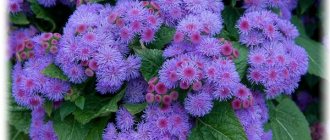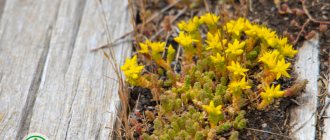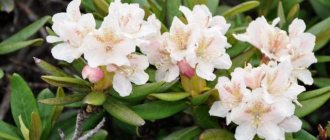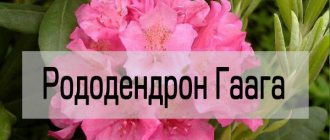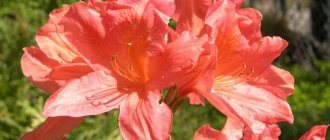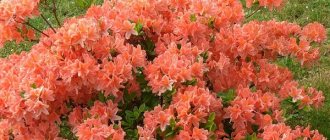Rhododendrons are ornamental, beautifully flowering shrubs of the Heather family, including more than 600 varieties of deciduous and evergreen forms. Rhododendrons came to gardens around the world from China, Japan, Korea, and some species grow naturally in the Caucasus, North America and Australia. IN
1854, during the expedition of the frigate "Pallada" to Southeast Asia, naval officer Alexander Egorovich Schlippenbach discovered a deciduous form with soft pink flowers, which later became the golden fund of landscape designers around the world and received his name.
Schlippenbach rhododendron will decorate the garden with soft pink blooms
Biological description
According to the botanical description, Rhododendron Schlippenbach has bell-shaped flowers with a diameter of 8-15 cm, rarely single, often collected in panicles of 3-6 pieces, sometimes blooming before the leaves. In modern varieties, the main color of the petals is pale pink, deep pink, white-pink, soft orange, soft carmine, white with purple specks at the base of the petals.
The flowering period in the Moscow region begins in mid-May, in Latvia and Finland in late May-early June and lasts 14-20 days, then boxes with small seeds are formed.
Important! Rhododendrons are poisonous plants due to their neurotoxin content, so you should not brew tea or prepare infusions and decoctions from their flowers and dried leaves.
Outstanding successes in the selection and cultivation of rhododendrons have been achieved at the University of Helsinki, whose botanical garden contains a collection of shrubs with high winter hardiness, and the Helsinki University variety tolerates frosts down to -40 °C.
Variety "Helsinki University"
Root system
In nature, the Schlippenbach rhododendron shrub is small in height, up to 60 cm, and it settles on dry rocky mountain slopes, which is why it is sometimes called the Alpine rose. Higher specimens (2-3 m) are found on the edges of forests with well-permeable soils. The rhododendron root is superficially creeping at a depth of 6-10 cm with a large number of small suction roots. Therefore, the crop cannot tolerate drying out of the soil.
Trunk and leaves
The stem and branches of the Schlippenbach rhododendron are bare, and a rosette of elongated shiny leaves with a smooth or slightly wavy edge is located at the very top. The shrub is not characterized by rapid growth; in one season it grows by 4-10 cm and at 10 years its height does not exceed 1 m.
Schlippenbach rhododendron bush at 10 years old
The main discovery of Alexander Schlippenbach.
“On August 30 (1853, author), Alexander’s Day, the birthday boy Baron Schliepenbach had breakfast on a corvette. It was a lot of fun."
A.I. Goncharov “Frigate Pallada”
You have to be “Ivans who don’t remember their kinship” to forget all the good things that came to us from Europe. Here we are not discussing such an obvious fact that Europe has been ahead of the rest of the world for many centuries, in other words, it is the driver of world development. Russia, according to a long tradition, is an importer of European achievements. I foresee ardent objections from the “patriots”. Like - “Russians are no more stupid than Europeans”, “Russians have made their contribution to world culture - just remember Tolstoy and Dostoevsky, whom the whole world worships.” But the catch is that these two geniuses would not have created anything if they had lived at the same time as Lenin and Stalin. At best, they would emigrate to Europe or the USA. And if they had stayed, they would have had a much richer choice: extrajudicial execution during the period of terror of the civil war; death at the hands of expropriators and bandits; death or degradation from hunger and deprivation in the first post-revolutionary years; death in the dungeons of the Cheka or the NKVD by the verdict of the troika “for espionage” in favor of the country where they once had a chance to visit, etc. and so on.
The 20th century clearly showed that the Russian “people” do not need culture as such. A crop is a tree with complex agricultural technology. We don't want to waste energy cultivating it. We only need its fruits. Meanwhile, Russia once owed its cultural flourishing to the Europeans. The Italians built the first churches and monasteries in Vladimir and Bogolyubovo. They built us our symbol and our enduring pride, the Moscow Kremlin. The Dutch built the first Russian sailing ship "Eagle" in Kazan, which was then transported along the Volga to the Caspian Sea to Astrakhan, where it was subsequently captured by the rebel Razin. The Germans gave us firearms, taught us fortification and various tactical tricks, thanks to which Siberia was conquered.
My mother was born in northern Kazakhstan, where several peoples lived mixed together. There were villages with a predominantly Russian-Ukrainian, Kazakh and German population. “I could tell by their appearance who lives where.” - she said. And it’s not even about the typical types of housing for these peoples. The German neatness in everything and the thoughtfulness of everyday details were striking. The Kazakh villages were the most miserable and dirty. Russians this way and that. The German ones are clean, tidy, there are flowers in every house.
They began inviting foreigners into Russian service already under the first Romanovs. But under Peter the Great this became state policy. It is quite obvious that it was simply impossible to come up with a wiser solution than the “Germanization” of Russia! After all, the Germans did not just give us “technology in exchange for oil.” Being carriers of a higher culture, Russian Germans gradually educated and re-educated us. Cooperation and friendship with the Germans turned Russia into one of the leading European powers. Albeit original, but quite developed and enlightened. By the beginning of the 19th century, foreigners, mainly Germans, were present in all administrative structures of the state. They set the tone wherever possible. They even encroached on Russian literature - remember the Russian classic Fonvizin (that is, the German von Vizin).
But especially many Germans began to arrive in Russia after several Russian-Turkish wars, when the territory of the state expanded significantly. The policy of attracting Germans during this period reached its climax. Throughout Germany one could find “ads” inviting ordinary Germans to move to Russia. German settlements appeared in the Middle Volga region. German colonists took an active part in the development of the southern territories newly annexed to Russia - Novorossiya.
German honesty and accuracy made them indispensable in government. That is why, and not “through connections,” as some believe, the Russian sovereigns entrusted them with the management of various state affairs. The Germans, essentially from scratch, created Russian science and then developed it. And what's wrong with that!? After all, over time they assimilated, and sometimes became more Russian than we ourselves. Take the same Vladimir Dahl, wasn’t it he who taught us to love the Russian language?!
The Germans formed the intellectual backbone of the Russian nation. It is well known that the first Russian academician Mikhailo Lomonosov fought against the dominance of the Germans in the Russian Academy of Sciences. At the same time, he not only studied in Germany, but was even married to a German woman. The Germans really were at that time “the plug of all barrels.” But it could not have been otherwise, because for us they were the founders of all sciences. Botany, for example, arose in our country exclusively thanks to the Germans. The first researchers of Russian flora were also completely Russified Germans. It was the Germans who gave many of our plants names that we now consider originally Russian. There were many Germans among those who developed and developed the Russian outskirts. Some made maps, others described the flora and fauna. Even among the top ten Russian navigators, almost half are German: Kruzenshtern, Bellingshausen, Kotzebue, Litke, Wrangel... The same is true among botanists: Glen, Gmelin, Maksimovich, Middendorf, Radde, Schmidt, Schrenk...
But I would like to tell you in more detail about the young naval officer, a Russian German, whose name is given to the hero of this story - the Schlippenbach rhododendron. Alexander Egorovich Schlippenbach (1830-1903), more precisely Baron von Schlippenbach, was a descendant of an ancient family of Baltic Germans. The distant ancestor of Alexander Schlippenbach was a Swedish citizen, but after Poltava he was forced to switch to Russian service. Peter the Great, as you know, not only favored the Germans, but one might say adored them. He treated the interned Baltic Germans extremely mercifully and even benevolently. All their estates were left to them, and noble privileges were retained. Among other things, he left behind them a baronial title, atypical for the Russian nobility. Alexander's father, Baron E.A. Schlippenbach was also a naval officer, captain of the first rank. Thus, naval service was a family tradition in their family. Alexander Schlippenbach's mother was born Countess M.L. Heyden.
In 1852-1855 The Russian government launched an unprecedented multi-purpose naval expedition to the Far East. Her main task was a diplomatic mission to Japan, with the aim of establishing various connections with its eastern neighbor. The plenipotentiary representative of Russia at them was Admiral Putyatin, later Count.
Several ships took part in the expedition. Among them was the schooner Vostok, whose main task was a comprehensive study of the coastline of the Russian Far Eastern possessions and the adjacent territories. The flagship ship of the expedition was the 62-gun frigate Pallada. At the time of sailing, midshipman Alexander Schlippenbach was 22 years old. But he was already a fairly experienced sailor, since at the age of 14 he was sent to the Naval Cadet Corps. And yet, sailing on Pallas became a serious test for Alexander, turning him from an ordinary sailor into a real sea wolf. Only an inexperienced "newcomer" believes that the main thing for a sailor is not to be afraid of pitching and stormy winds. Only courage allows a sailor to become a captain. Alexander was originally endowed with the best human qualities: courage, determination, initiative, honesty. They allowed him to overcome all the trials sent down to him with honor. During the voyage, Schlippenbach was alternately on the frigate and on the schooner, which was mainly engaged in “research” activities. He began his voyage with the rank of midshipman on a frigate, and ended it as a captain-lieutenant, commander of the schooner Vostok.
It should be noted that the naval service captured Alexander Schlippenbach so much that it left no room for his personal life. Therefore, he married only after retiring in 1864 - at the age of 34, to the widow of a Moscow merchant of the 2nd guild, Pelageya Vasilyeva, who already had a son. They had three more children - two daughters and a son. Everyone, including the stepson, was given a decent upbringing. Alexander retired with the rank of major general.
The story of the discovery of rhododendron by Alexander Schlippenbach is as follows. Among other duties, he was entrusted with collecting the herbarium. Officially, this assignment was called “plant collector.” As fate would have it, the schooner Vostok approached the east coast of Korea in April 1854, just at the height of the rhododendron flowering. This made it possible to make a full-fledged herbarium specimen of the shrub, which, along with other plants, was sent to the St. Petersburg Botanical Garden for study and identification.
Reproduction methods
Caucasian rhododendron in the mountains: when to bloom
Reproduction of rhododendrons is possible vegetative and seed. To preserve varietal qualities, cuttings and rooting of layering are used. In order to develop a new variety or hybrid, seeds cross-pollinated with the desired species are sown.
Vegetative method
Within 3-4 weeks, the shoots produce roots in a substrate with peat, humus from pine needles and sand, which is taken in half the amount of other ingredients. For rooting, you can take the branched tips of the shoots without dividing the branches. They root better than individual cuttings.
Shoot tip for rooting
Temperature
Shoots and cuttings can be rooted at the end of summer in open ground or in a greenhouse in February. The optimal air temperature for rooting is 16-24 °C, air humidity is close to 100%. If it is difficult to maintain such a temperature in the greenhouse in winter, it is enough for the substrate to be heated to 10-12 °C.
Propagation by cuttings
Individual cuttings from 5 to 15 cm long are planted in August on the garden bed in rows with a distance of 15-20 cm, 8-10 cm between cuttings. Watering is carried out daily, possibly with a sprinkler. Container rooting is practiced in the greenhouse. The cuttings are buried 2-3 cm in cups with substrate and covered with glass jars or plastic bottles.
Rooting cuttings in a container
The plants are ventilated every day for 30-40 minutes, the soil in the container is slightly loosened to avoid the proliferation of mold fungi and putrefactive bacteria. A signal of successful rooting is the beginning of the growth of new leaves on the shoot.
Reproduction using taps
Rhododendron is easy to propagate vegetatively in the garden. To do this, after flowering, select the lowest branches, bend them to the ground and pin them with a wire staple so that the whorl with branching shoots is underground. It is sprinkled with peat on top and moistened every 4-5 days. In autumn, the shoot is cut off from the mother plant with pruning shears and dug up so as not to damage the roots.
Step-by-step care instructions
Choosing a planting location - the best option for it would be a place next to any body of water - a pool or pond, then you will not have to worry about maintaining the required humidity. You also need to take into account that the shrub will feel good in partial shade - it needs diffused light. It is important to reliably protect it from strong winds so that it does not end up in a draft. You cannot plant Rhododendron next to oak, birch and willow, they will oppress each other.- What should the soil be like ? It should be slightly acidic or acidic and loose, then the shrub will develop successfully and bloom profusely. It must contain peat, humus, sand, and turf soil.
- Landing — planting a plant in spring is, of course, always safer.
- First, the seedling needs to be placed in some container with warm water.
- Then we begin to prepare the planting hole. We dig it out twice as large as its root system.
- We first fill it with drainage, then you can add a little pine needles, then prepared soil (from peat, sand, humus and turf soil).
- We take the soaked seedling out of the water, let the water drain a little and then plant it in the prepared place.
- After planting, be sure to water well.
- When the water is absorbed, we make a tree trunk circle on top and add a layer of pine bark (or pine needles).
- Temperature - can withstand 26 degrees of frost and 30 degrees of heat, but this beauty feels best in the temperature range from minus 10 to plus 20 degrees.
- Watering - since the soil should always be in a semi-moist state, good watering is needed. In hot weather, it is possible to water 2 or 3 times a week - you need to look at the weather. A mandatory requirement for water is that it must be soft, preferably rainwater; it is also useful to periodically use acidified water for irrigation.
- Fertilizing - the plant must be fertilized at least 2 - 3 times a season.
The first time after winter we fertilize at the beginning of April, then in the summer, after flowering ends, and in the fall (September - October). Reference! Top dressing can be organic (peat plus humus) or special mineral complex (for Rhododendrons). - Pruning - you can do a little pruning in March - April, remove all the branches damaged during the winter and, if you really want, slightly adjust the shape of the bush (although it always looks gorgeous). You shouldn’t get carried away with pruning, so as not to weaken the plant.
- Transplantation - can be replanted in spring and summer (not advisable in autumn). During the process of transplanting, try not to disturb the earthen lump, then the whole process of adaptation to the new place will be easier. After the Rhododendron has already been transplanted, you need to water it abundantly and mulch the tree trunk circle.
Selection and preparation of a landing site
Choosing a place for rhododendron, where to plant a single bush or a group of plants on the site is a difficult question, since the plantings will grow in the same place for 20-30 years or more. Moreover, these plants are difficult to grow. They do not like open sun, in which case the foliage may turn brown.
Rhododendron Helliki: description
The site must be protected from strong winds and stagnant melt water. If the soil does not drain water well, drainage is needed under the bush.
Note! The soil should be acidic with a pH of 5-6
In terms of design solutions, the bushes look especially attractive if they are planted at some distance from each other in the form of multi-colored spots against the backdrop of an emerald lawn.
Characteristics of the variety
Rhododendron Francesca is characterized not only by high decorative qualities. It is also distinguished by good survival characteristics and resistance to adverse weather conditions. This makes maintenance much easier.
Important! Despite the high levels of winter hardiness, when cultivating Francesca in the northern regions, plants under 5 years of age require shelter for the winter. Features of the Francesca rhododendron variety:
Features of the Francesca rhododendron variety:
- plant height - from 1 to 1.7 m;
- crown diameter - from 1 to 1.8 m;
- flowering - starts in the second half of May and lasts from 2 to 3 weeks;
- inflorescences - include 17–26 flowers measuring 5.5x7 cm;
- growth rate is high, approximately 10 cm/year;
- frost resistance - tolerates temperature drops down to –30°C without shelter.
The Francesca variety prefers well-drained, moisture-permeable soils with an acidic reaction (3.5–4.5 pH). Does not tolerate open sunlight and drafts. Grows better in partial shade. In terms of moisture, it is demanding, like all representatives of rhododendrons. At the same time, it grows poorly and often gets sick in wetlands. If all the rules of agricultural technology are followed, it is rarely affected by diseases and pests.
Pay attention to the information about another variety of hybrid rhododendron - Grandiflorum.
How to care for a garden rhododendron flower
Caring for plants consists of shaping and pruning, watering and fertilizing, covering the bushes for the winter and protecting them from spring frosts.
Fertilizers
In the spring, to stimulate growth and flowering, nitrogen-phosphorus fertilizer Ammophos 30-40 g is given to the bushes near the trunk, after removing the mulch. In August, 20 g of superphosphate and 30 g of potassium sulfate are added in the same way. To increase the decorative appearance of leaves during the growing season, foliar feeding with complexes with microelements is recommended.
Trimming
Young bushes require formative pruning in the second or third year of planting. Select a central strong shoot 40-45 cm long and cut off its top. During the summer, it begins to produce many side shoots, the plant bushes and acquires a lush, spreading shape. In subsequent years, pruning is reduced to sanitary. Remove old branches that are too long, diseased and broken shoots.
Preparing rhododendron for wintering
At the end of September, frames are prepared for rhododendrons, which are then covered with white covering material. Plants have a long growing season of up to 200 days and not in all regions they have time to shed their leaves before winter. This happens already under a spacious shelter. In spring, the plant wakes up early and throws out buds, the frame protects them from frost, and there is enough light for it under the fabric.
Frame
How to prepare a shelter for winter
How the plant endures winter will determine its flowering. There are deciduous and evergreen rhododendrons, all of which differ in winter hardiness. If you don’t want to risk your pet, it’s worth building a shelter, this is especially true for young specimens, even frost-resistant ones.
The bush must be covered with roofing felt or some kind of frame shelter used for this purpose. Significant damage to the bush is caused by heavy snowfalls and strong winds. To prevent azaleas from freezing, experienced gardeners construct special protective structures from polyurethane foam or polypropylene.
You can remove the shelter sometime in April, do not delay it too much, so that the handsome man does not interfere with you, having previously chosen a cloudy day, as if preparing the plant for the external environment and not getting sunburned.
Diseases and pests
Among the diseases, ornamental shrubs can be affected by a viral mosaic in the form of rusty spots on leaves and growths, tracheomycosis and late blight. To combat these diseases, the drugs Fundazol, Strobi, Skor are used. Insect pests that sometimes settle on rhododendrons are spider mites, tobacco thrips, and acacia false scale insects. In this case, the drugs Aktara, Karate Zeon, Fufanon are effective.
The rhododendron garden is magnificent in its bloom! It is enough to follow the recommendations on how to plant, grow and care for garden rhododendron flowers, and the plants will definitely delight you with their fragrance.
What is the difference from other types
This type of Rhododendron stands out from the rest due to the unusual shape of its leaves, as well as the fact that its beautiful large flowers smell very pleasant.
We talked about other types of rhododendron that will take their rightful place in your garden plot in separate articles. Read about these varieties: Azurro, Fantastica, Francesca, Rasputin, Ledebura, Golden, Daursky, Polarnakht, Hague and Katevbinsky.
